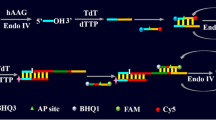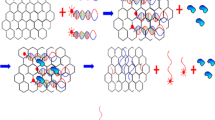Abstract
A multifunctional DNA nanocage containing CdTe quantum dots (QDs) was prepared. It was applied to the fluorometric detection of human 8-oxoG DNA glycosylase 1 (hOGG1) by exonuclease-assisted cycling amplification technique. When loaded with the cancer drug doxorubicin (Dox), the nanocage is also a versatile probe for fluorescence imaging of cancer cells, and drug delivery to them. The presence of hOGG1 leads to the division of DNA HP1 (containing 8-oxo-dG) and formation of DNA fragments 1 and 2. Then, HP2 is added to hybridize with DNA 1 and produced lots of trigger DNA (containing nucleolin aptamer) by Exo III-aided cycling amplification. The DNA nanocage was fabricated by linking the trigger DNA to multiple specific DNA strands, and the fluorescent CdTe QDs were further conjugated to the DNA nanocage for sensitive detection of hOGG1 activity. After Dox is incorporated into the DNA nanocage, the fluorescence of Dox is turned off. Once the DNA nanocage enters the MCF-7 cells, the Dox is released and its fluorescence (measured at excitation/emission wavelengths of 480/560 nm) is turned on. The DNA nanocage containing fluorescent QDs and Dox was successfully applied to the fluorometric detection of hOGG1, fluorescence imaging, and therapy of cancer cells, which has great promise in clinical application and treatment of cancer.

A multifunctional DNA nanocage containing CdTe quantum dots and acting as a signalling probe was prepared. It was applied to fluorometric determination of human 8-oxoG DNA glycosylase 1 using cycling amplification technique. It also enables drug delivery to cancer cells if loaded with doxorubicin.







Similar content being viewed by others
References
Yao J, Yang M, Duan Y (2014) Chemistry, biology, and medicine of fluorescent nanomaterials and related systems: new insights into biosensing, bioimaging, genomics, diagnostics, and therapy. Chem Rev 114:6130–6178
Bruchez MJ, Moronne M, Gin P, Weiss S, Alivisatos AP (1998) Semiconductor nanocrystals as fluorescent biological labels. Science 281:2013–2016
Peng H, Zhang L, Kjallman THM, Soeller C, Travas-Sejdik J (2007) DNA hybridization detection with blue luminescent quantum dots and dye-labeled single-stranded DNA. J Am Chem Soc 129:3048–3049
Jie GF, ZhaoY WXC, Ding CF (2017) Multiplexed fluorescence detection of microRNAs based on novel distinguishable quantum dot signal probes by cycle amplification strategy. Sensors Actuators B 252:1026–1034
Hildebrandt N, Wegner KD, Algar WR (2014) Luminescent terbium complexes: superior Förster resonance energy transfer donors for flexible and sensitive multiplexed biosensing. Chem Rev 273/274:125–138
Algar WR, Kim H, Medintz IL, Hildebrandt N (2014) Emerging non-traditional Förster resonance energy transfer configurations with semiconductor quantum dots: investigations and applications. Chem Rev 263/264:65–85
Wang J (2006) Electrochemical biosensors: towards point-of-care cancer diagnostics. Biosens Bioelectron 21:1887–1892
Chang ZF, Jing LM, Chen B, Zhang MS, Cai XL, Liu JJ, Ye YC, Lou XD, Zhao ZJ, Liu B, Wang JL, Tang BZ (2016) Rational design of asymmetric red fluorescent probes for live cell imaging with high AIE effects and large two-photon absorption cross sections using tunable. Chem Sci 7:4527–−4536
Zhu Y, Chandra P, Shim Y (2013) Ultrasensitive and selective electrochemical diagnosis of breast cancer based on a hydrazine–Au nanoparticle–aptamer bioconjugate. Anal Chem 85:1058–1064
Basuki JS, Esser L, Duong HTT, Zhang Q, Wilson P, Whittaker MR, Haddleton DM, Boyer C, Davis TP (2014) Magnetic nanoparticles with diblock glycopolymer shells give lectin concentration-dependent MRI signals and selective cell uptake. Chem Sci 5:715–726
Wang J, Christison T, Misuno K, Lopez L, Huhmer A, Huang Y, Hu S (2014) Metabolomic profiling of anionic metabolites in head and neck cancer cells by capillary ion chromatography with Orbitrap mass spectrometry. Anal Chem 86:5116–5124
Chen X, Lin YH, Li J, Lin L-S, Chen G-N, Yang H-H (2011) A simple and ultrasensitive electrochemical DNA biosensor based on DNA concatamers. Chem Commun 47:12116–12118
Huang J, Wu YR, Chen Y, Zhu Z, Yang XH, Yang CJ, Wang KM, Tan WH (2011) Pyrene-excimer probes based on the hybridization chain reaction for the detection of nucleic acids in complex biological fluids. Angew Chem Int Ed 50:401–404
Huang JH, Su XF, Li ZG (2012) Enzyme-free and amplified fluorescence DNA detection using bimolecular beacons. Anal Chem 84:5939–5943
Jie GF, Yuan JX (2012) Novel magnetic Fe3O4@CdSe composite quantum dot-based Electrochemiluminescence detection of thrombin by a multiple DNA cycle amplification strategy. Anal Chem 84:2811–2817
He Y, Xing XJ, Tang HW, Pang DW (2013) Graphene oxide-based fluorescent biosensor for protein detection via terminal protection of small-molecule-linked DNA. Small 9:2097–2101
Shi C, Zhao CH, Guo QJ, Ma CP (2011) Entropy-driven molecular switch and signal amplification for homogeneous SNPs detection. Chem Commun 47:2895–2897
Jie GF, Lu ZK, Zhao Y, Wang XC (2017) Quantum dots bilayers/au@ag-based electrochemiluminescence resonance energy transfer for detection of thrombin by autocatalytic multiple amplification strategy. Sensors Actuators B 240:857–862
Jamieson T, Bakhshi R, Petrova D (2007) Biological applications of quantum dots. Biomaterials 28:4717–4732
Schüller VJ, Heidegger S, Sandholzer N (2011) Cellular Immunostimulation by CpG-sequence-coated DNA origami structures. ACS Nano 5:9696–9702
Ren J, Jenkins TC, Chaires JB (2000) Energetics of DNA intercalation reactions. Biochemistry 39:8439–8447
Phillips DR, Greif PC, Boston RC (1988) Daunomycin-DNA dissociation kinetics. Mol Pharmacol 33:225–230
Luna L, Rolseth V, Hildrestrand GA (2005) Dynamic relocalization of hOGG1 during the cell cycle is disrupted in cells harbouring the hOGG1-Cys326 polymorphic variant. Nucleic Acids Res 33:1813–1824
Hill JW, Evans MK (2006) Dimerization and opposite base-dependent catalytic impairment of polymorphic S326C OGG1 glycosylase. Nucleic Acids Res 34:1620–1632
Li Q, Huang L, Rong L (2011) hOGG1 Ser326Cys polymorphism and risk of childhood acute lymphoblastic leukemia in a Chinese population. Cancer Sci 102:1123–1127
Su YH, Lee YL, Chen SF, Lee YP, Hsieh YH, Tsai JH, Hsu JL, Tian WT, Huang WY (2013) Essential role of β-human 8-oxoguanine DNA glycosylase 1 in mitochondrial oxidative DNA repair. Environ Mol Mutagen 54:54–64
Gackowski D, Speina E, Zielinska M, Kowalewski J, Rozalski R, Siomek A, Paciorek T, Tudek B, Olinski R (2003) Products of oxidative DNA damage and repair as possible biomarkers of susceptibility to lung cancer. Cancer Res 63:4899–4902
Weiss JM, Goode EL, Ladiges WC, Ulrich CM (2005) Polymorphic variation in hOGG1 and risk of cancer: A review of the functional and epidemiologic literature. Mol Carcinog 42:127–141
Yuan F, Zhao HM, Liu M, Quan X (2015) Visible assay for glycosylase based on intrinsic catalytic ability of graphene/gold nanoparticles hybrids. Biosens Bioelectron 68:7–13
Wang XZ, Hou T, Lu TT, Li F (2014) Autonomous exonuclease III-assisted isothermal cycling signal amplification: a facile and highly sensitive fluorescence DNA glycosylase activity assay. Anal Chem 86:9626–9631
Chan MS, Tam DY, Dai Q (2016) Mitochondrial delivery of therapeutic agents by amphiphilic DNA Nanocarriers. Small 2:770–781
Li Y, Tian C, Liu Z (2015) Structural transformation: assembly of an otherwise inaccessible DNA Nanocage. Angew Chem Int Ed 54:5990–5993
Xia Z, Wang P, Liu X (2016) Tumor-penetrating peptide-modified DNA tetrahedron for targeting drug delivery. Biochemistry 55:1326–1331
Li X, Yu Y, Ji Q (2015) Targeted delivery of anticancer drugs by aptamer AS1411 mediated Pluronic F127/cyclodextrin-linked polymer composite micelles. Nanomed-Nanotechnol 11:175–184
Acknowledgements
This work was supported by the National Natural Science Foundation of China (No.21575072), and the Key Research and Development Plan of Shandong Province (2016GGX102021).
Author information
Authors and Affiliations
Corresponding author
Ethics declarations
The author(s) declare that they have no competing interests.
Additional information
Publisher’s Note
Springer Nature remains neutral with regard to jurisdictional claims in published maps and institutional affiliations.
Electronic supplementary material
ESM 1
(DOC 846 kb)
Rights and permissions
About this article
Cite this article
Jie, G., Gao, X., Ge, J. et al. Multifunctional DNA nanocage with CdTe quantum dots for fluorescence detection of human 8-oxoG DNA glycosylase 1 and doxorubicin delivery to cancer cells. Microchim Acta 186, 85 (2019). https://doi.org/10.1007/s00604-018-3199-2
Received:
Accepted:
Published:
DOI: https://doi.org/10.1007/s00604-018-3199-2




